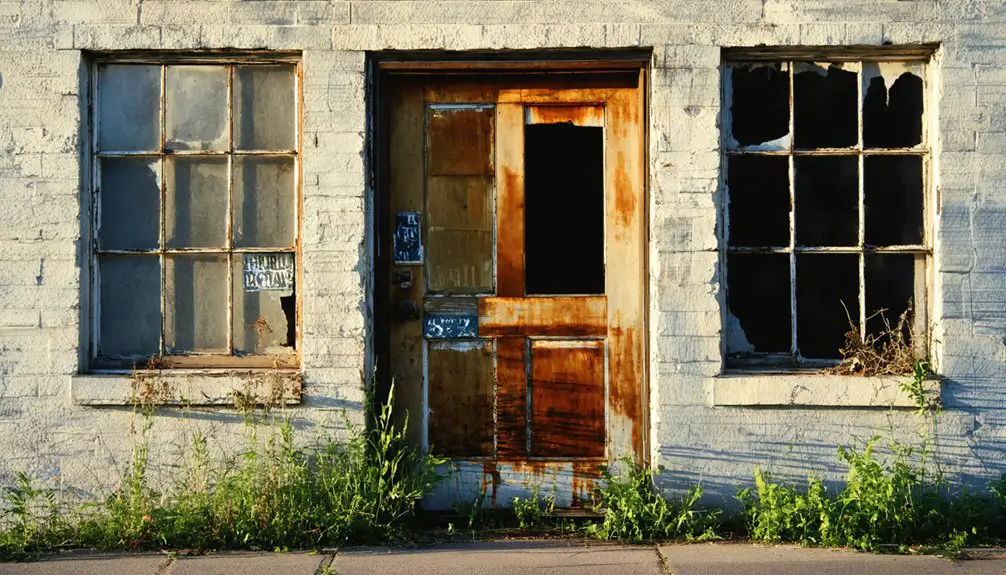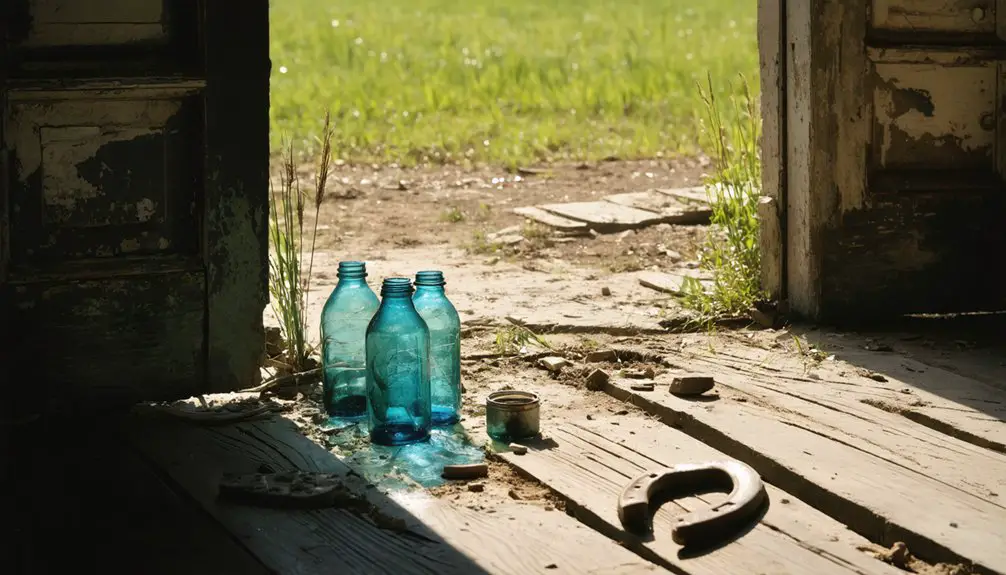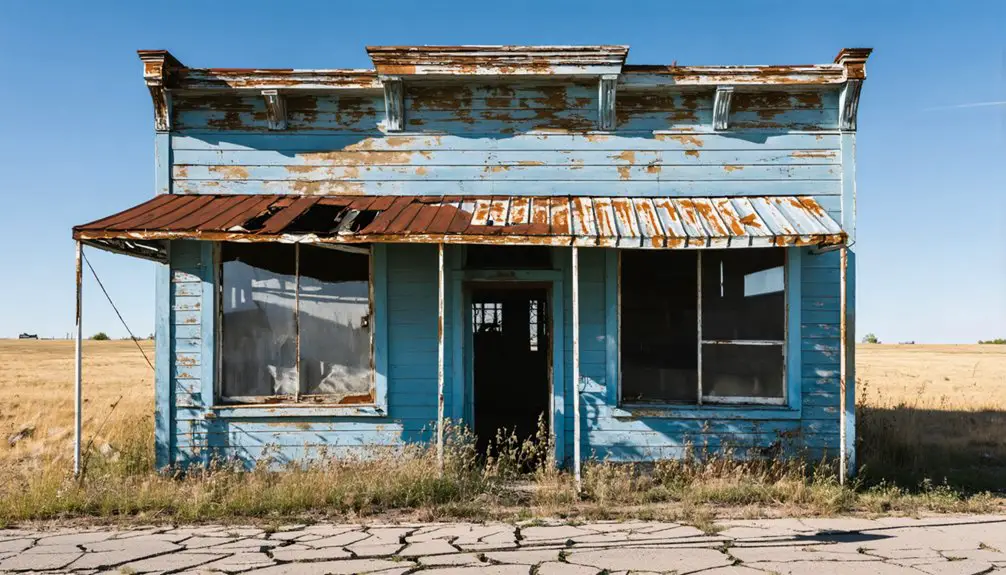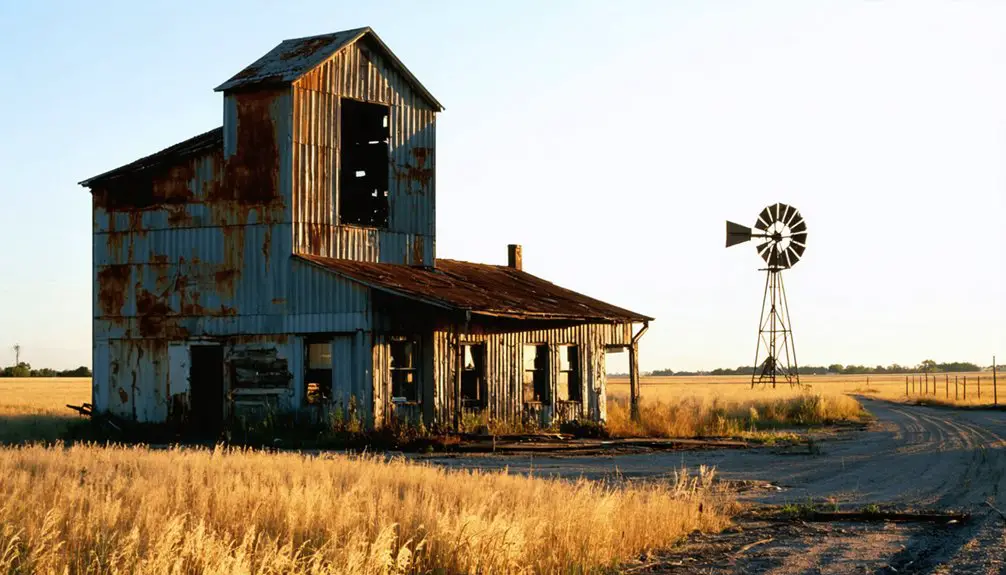You’ll discover Havana’s ghost town ruins in southeast Kansas, where this once-bustling frontier stagecoach stop emerged in 1870. The town peaked at 318 residents in 1920 before declining to just 84 today. You can explore remnants of the grand stone hotel, Santa Fe Trail ruts, and the old stagecoach station that served German and French immigrant families. The scattered foundations and artifacts tell a deeper story of Kansas’s ambitious frontier dreams.
Key Takeaways
- Havana was established around 1870 as a railroad town in southeast Kansas, originally named Bulltown before becoming Havana.
- The town reached its peak population of 318 residents in 1920 after the railway’s arrival but experienced steady decline afterward.
- Historic remnants include stagecoach station ruins, Santa Fe Trail ruts, and the grave of U.S. Army dragoon Samuel Hunt.
- German and French immigrants established a thriving stagecoach stop community with a stone hotel and brewery complex.
- Today, Havana is largely abandoned with only 84 residents, scattered ruins, and foundations marking where the settlement once stood.
Origins of a Frontier Station
While many Kansas frontier settlements emerged organically during westward expansion, Havana’s establishment around 1870 marked a deliberate addition to southeast Kansas’s growing network of railroad stations.
You’ll find frontier naming patterns here that mirror nearby towns like Ravanna, where settlers often chose names reflecting their origins or local geography. The town was originally called Bulltown after settler John Bull before adopting its current name. Like other towns during the period, the settlement emerged during the decline of Indian Wars as more pioneers moved westward.
Life Along the Stagecoach Route
At Havana Station, you’d find travelers exchanging their tired horses for fresh teams while station hands hurriedly loaded mail bags and cargo onto waiting coaches.
You could watch as weary passengers stretched their legs at the small hotel, enjoying hot meals while socializing with the station’s fifty German and French families who’d settled nearby.
The daily rhythms of frontier life centered around the station’s store and hotel, providing essential services to travelers and locals alike. The daily rhythms of frontier life centered around the station’s six buildings, where stagecoach arrivals brought news, commerce, and brief moments of connection between settlers and those journeying west on the Santa Fe Trail. The station served as a vital stop until rail lines arrived in 1869, marking the beginning of the end for this once-bustling waypoint.
Daily Travel Station Activities
From sunrise to sunset, life at the Havana Stage Station buzzed with constant activity as travelers, station staff, and stagecoach crews moved through their daily routines along the Santa Fe Trail.
Built in 1858, this historic station became a crucial stop for weary travelers making their way across Kansas Territory.
You’d find workers readying horses, preparing meals, and maintaining the hotel while adhering to strict stagecoach schedules that kept commerce flowing through Kansas Territory.
At the station’s hotel and store, you could rest, refuel, and stock up on supplies alongside fellow adventurers. Fifty German and French families living in the area helped provide essential services to the steady stream of travelers.
Station hands worked around the clock, feeding and watering horses, coordinating driver changes, and ensuring quick turnarounds for the next leg of journey.
The bustle of daily traveler routines brought together a mix of merchants, settlers, and passengers, creating a vibrant hub of frontier activity until the railroad’s arrival in the early 1870s changed everything.
Stagecoach Community Social Life
Life along the Santa Fe Trail centered around bustling stagecoach stops where travelers, station operators, and local residents forged tight-knit social bonds.
You’d find yourself swept up in the stagecoach camaraderie as passengers shared travel tales and broke bread together in rustic station basements or farmhouse dining rooms. The historic stone house at Mahaffie served as a dining hall where travelers gathered for meals and conversation. At stops like Havana, Kansas, communal gatherings brought locals and travelers together to exchange news, collect mail, and celebrate special events.
Inside the coaches, you’d need to mind your manners – no cursing, smoking near ladies, or resting your head on fellow passengers. The journey from Missouri to Santa Fe could take up to fifteen days by stagecoach, making these social rules essential for peaceful travel.
Station families welcomed weary travelers with simple meals and basic lodging, creating a homey atmosphere despite the dirt floors and crude accommodations. These social connections helped tame the isolation of frontier life.
The Rise and Fall of Havana
You’ll find Havana’s early growth tied closely to its role as a stagecoach stop, where German and French settlers established ambitious ventures including a stone hotel, distillery, and brewery around 1870.
The town’s fortunes shifted dramatically after 1886 when the Atchison, Topeka and Santa Fe Railway arrived, initially boosting the population to peaks of 227 in 1910 and 318 in 1920, but ultimately contributing to its decline as transportation patterns changed. With a current population of just 84 residents, the town continues its steady decline.
Today, you can spot traces of Havana’s past in the old stagecoach station ruins and Santa Fe Trail ruts, while the repurposed hotel-turned-barn and converted distillery stand as silent witnesses to the town’s former aspirations. The grave of U.S. Army dragoon Samuel Hunt, who died in 1835 while serving along the trail, remains a significant historical marker across the highway.
Early Stagecoach Hub Development
In 1858, Havana emerged as a significant stagecoach hub along the Santa Fe Trail when developers strategically established the settlement near Dragoon Creek’s natural rock crossing. The bustling stagecoach routes brought weary travelers through this important rest stop, where you’d find essential amenities supporting your westward journey.
- A large stone hotel featuring native walnut doors and windows offered comfortable lodging
- A well-stocked store provided necessary supplies for your trail journey
- The stage station served as both a mail stop and traveler refuge until 1869
- A stone distillery and brewery catered to thirsty pioneers
- The location near Dragoon Creek’s crossing made it a natural stopping point
Today, you can still spot the trail ruts west of where the stage station once stood, silent witnesses to countless traveler experiences along this historic route.
Lost To Railroad Progress
While Havana initially benefited from the Chicago, Kansas & Western Railroad‘s arrival in 1886, the town’s fate would ultimately rest on shifting railway priorities.
You can trace the town’s rise and fall through fierce railroad competition between the Santa Fe’s CK&W and Missouri Pacific’s DM&A lines racing westward through Chautauqua County.
Though Havana grew to 318 residents by 1920, its economic decline began when cattle shipments from Elgin dwindled.
Santa Fe’s abandonment of the Cedar Vale branch before WWII dealt the final blow.
Today, you’ll find only limestone culverts and bridge abutments marking where Italian craftsmen once built the railway.
With just 84 residents remaining, Havana stands as a reflection of how Kansas towns lived and died by the railroad’s presence – their destinies shaped by steel rails that gave life, then took it away.
Ruins Tell Hidden Stories
The remnants of Havana tell a more complex story than just another railroad ghost town. As you explore the hidden narratives of this once-promising settlement, you’ll discover forgotten memories of ambitious German and French immigrants who dreamed of prosperity in Kansas Territory.
- The grand stone hotel, built with native walnut, stood as a symbol of early optimism before becoming a humble barn.
- A sophisticated distillery and brewery complex reflected the settlers’ entrepreneurial spirit.
- The surviving stagecoach station ruins mark Havana’s role in frontier transportation.
- Santa Fe Trail ruts west of town preserve evidence of broader historical movements.
- U.S. Army dragoon Samuel Hunt’s grave connects the site to military frontier history.
Walking these grounds today, you’ll find private property where wealthy merchants once established a European-inspired settlement, only to see their dreams fade through economic struggles and community discord.
What Remains Today

Modern visitors to Havana, Kansas will find little more than scattered ruins marking this once-hopeful settlement, with the most prominent remains being the deteriorating walls and foundations of the Havana Stage Station and hotel. A posted sign identifies these historical structures, offering a glimpse into the town’s past significance as a frontier outpost.
You’ll discover the site nestled in the secluded Flint Hills region, where limestone outcrops and pastoral lands have reclaimed much of the original townsite. The old railroad tracks and roadways have largely disappeared beneath encroaching vegetation, while abandoned transportation routes fade into the landscape.
Current observations reveal no active businesses or residents, and beyond the stage station ruins, most other structures have vanished entirely, leaving only traces of this forgotten Kansas community.
Transportation’s Impact on Settlement
Railroads transformed Havana’s destiny when the Atchison, Topeka and Santa Fe Railway extended its line to the settlement in 1886. The transportation evolution radically changed settlement dynamics, turning a fledgling post office established in 1871 into an incorporated town by 1910.
You’ll find that Havana’s growth directly mirrored its transportation access:
- Population surged from 227 to 318 between 1910-1920
- Named after Havana, Illinois, reflecting early settlement patterns
- Railway expansion created essential economic lifelines
- Cattle shipping became critical to the local economy
- Geographic isolation later contributed to decline
As transportation routes shifted and railways moved elsewhere, Havana’s fortunes waned. The town’s dependence on rail access ultimately proved to be both its blessing and its curse, leading to its eventual ghost town status.
Archaeological Discoveries

While Havana’s modern ghost town status draws curious visitors, significant archaeological discoveries in the surrounding region have revealed a rich prehistoric past.
You’ll find the archaeological significance of nearby sites like Quarry Creek, where over 20,000 chipped stone artifacts and diverse plant remains tell stories of ancient habitation. The site’s indigenous artifacts include tools, ceramics, and animal remains spanning thousands of years.
At nearby Etzanoa, you can explore evidence of a lost Native American city where Spanish cannon balls and horse artifacts confirm colonial contact.
The region’s ceramic collections show strong connections to Hopewell cultures, with radiocarbon dating placing settlements between AD 780-970. These discoveries paint a picture of thriving prehistoric communities that utilized the landscape long before Havana’s establishment.
Local Stories and Legends
Beyond the ancient artifacts and archaeological sites, Havana’s legacy lives on through the colorful stories passed down by generations of local residents.
You’ll find a rich tapestry of community folklore woven into the town’s history, from tales of railroad prosperity to haunting ghost tales that echo through abandoned buildings.
- Methodist church gatherings once formed the heart of local social life, bringing families together in close-knit fellowship.
- The old grocery store and other empty structures spark eerie tales of supernatural encounters.
- Railroad stories tell of boom times when the Atchison, Topeka and Santa Fe line brought energy to town.
- Local ghost tales mention mysterious sounds and apparitions, drawing amateur paranormal investigators.
- Despite population decline, remaining residents keep cultural memory alive through storytelling and preservation efforts.
Preserving Kansas History

As preservationists work to document Kansas’s vanishing heritage, Havana stands as a prime example of the challenges facing historical conservation efforts across the state.
You’ll find that private land ownership and natural decay create significant preservation challenges, making it essential to document what remains while it’s still possible.
Local historical societies are working to maintain cultural memory through various initiatives. You can explore their efforts in documenting original buildings, preserving Samuel Hunt’s grave, and recording the town’s economic history.
They’re creating informational plaques, virtual tours, and educational materials to keep Havana’s story alive. While funding remains limited and physical evidence continues to deteriorate, partnerships between preservation groups and landowners are helping protect these important pieces of Kansas history for future generations.
Planning Your Visit
Since Havana isn’t actually a ghost town, you’ll want to focus your visit on exploring nearby historical sites like Ravanna instead.
When planning your trip, consider these essential travel tips to make the most of your Kansas adventure. You’ll need to rely on your own vehicle and GPS navigation, as public transportation isn’t available in these rural areas.
- Book your accommodation options in advance, as lodging can be limited in small towns
- Pack appropriate clothing and gear for unpredictable Kansas weather
- Bring plenty of water and emergency supplies, as services may be hours away
- Download offline maps since cell service can be spotty in remote areas
- Research private property boundaries to ascertain you’re exploring permitted areas
Frequently Asked Questions
What Native American Tribes Originally Inhabited the Havana Area Before Settlement?
You’ll find the Kanza (Kaw) tribe primarily inhabited your area’s Native American cultural heritage, while the Osage ranged nearby. The Pawnee and Comanche occasionally passed through these lands.
Were There Any Notable Crimes or Lawlessness Reported in Havana’s Stagecoach Days?
As quiet as a ghost at midnight, you won’t find records of stagecoach robberies or law enforcement challenges at this stop. The German and French families kept peace during its 1858-1869 operation.
What Was the Peak Population of Havana During Its Most Prosperous Period?
You’ll find that Havana’s history reached its peak prosperity in 1940 with 305 residents – the highest population ever recorded before the town’s long decline into today’s dwindling numbers.
Did Any Famous Historical Figures Pass Through or Stay at Havana Station?
While Havana Station had historical significance as a Santa Fe Trail stop, you won’t find records of famous visitors there. Military personnel, immigrants, and everyday travelers made up most of its documented traffic.
How Much Did It Cost to Stay Overnight at Havana’s Hotel?
If you’d traveled the Santa Fe Trail in the 1850s-60s, you’d have paid around $1-3 per night for hotel rates at Havana’s basic overnight accommodations, though exact prices weren’t documented.
References
- https://www.visitgck.com/eminence-and-ravanna-the-story-of-finney-countys-ghost-towns/
- https://www.hhhistory.com/2019/05/ghost-towns-of-kansas.html
- https://www.youtube.com/watch?v=alC1wDdSVvg
- https://legendsofkansas.com/kansas-ghost-town-list/
- https://journal.prairiedust.net/2009/03/03/havana-stage-station/
- https://www.quincyvagell.com/2019/09/25/ravanna/
- https://www.youtube.com/watch?v=Ra5RjaN6A_c
- https://www.youtube.com/watch?v=AIyhx6xT-S8
- https://theclio.com/entry/189648
- https://www.legendsofamerica.com/ks-santafetrailosco/



